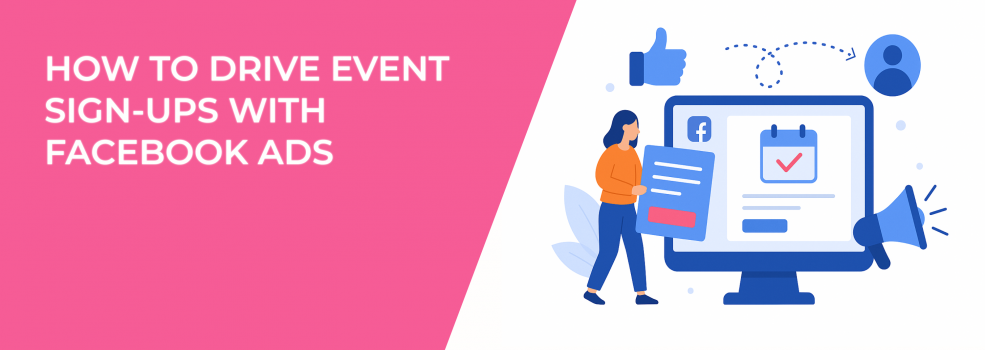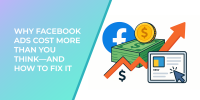You’ve booked the speakers, built the landing page, and picked the perfect date. Now what?
If your audience doesn’t know the event exists — or doesn’t feel like it’s worth their time — all that prep goes nowhere.
That’s why Facebook Ads are such a powerful tool. They can help you reach the right people, spark interest, and turn curiosity into confirmed registrations. But throwing up a few boosted posts won’t cut it. You need a system.
Here’s how to plan, build, and launch Facebook ad campaigns that don’t just get clicks — they get sign-ups.
Know your “why”
Every event solves a problem. But too often, advertisers focus on the what instead of the why.
Let’s say you’re promoting a webinar titled “Social Media Trends 2025.” That sounds informative, but not urgent. Why should your audience care?
A better hook might be: “5 Social Media Shifts That Could Make or Break Your Brand Next Year.” Suddenly, it’s not just a webinar. It’s a wake-up call.
Imagine you're running a virtual summit for real estate professionals. Instead of just saying “Join us for 3 days of real estate insights,” try: “Struggling with low inventory and high client churn? Discover the lead gen systems top agents are using right now — no fluff, just what works.”
By identifying your audience’s pain points and aspirations, your message becomes more magnetic. Talk about results, not just topics.
Pro tip: interview a few past attendees or people in your target niche. What made them sign up for previous events? Use their exact words in your copy.
Build a full funnel (even for free events)
Most advertisers run one ad, expect sign-ups, and move on. But event campaigns work better as a funnel — with multiple stages.
Here’s how to structure it:
-
Awareness: use a video ad with a strong narrative. For example, a short clip of the event host asking a key question: “Are you still relying on outdated tactics to drive holiday sales?” This grabs attention and sparks interest without asking for anything.
-
Consideration: retarget viewers or engagers with a second ad. This one should be more specific — perhaps showing the speaker lineup or a sneak peek of the agenda. Include a CTA, like: “See what you’ll learn — seats are limited.”
-
Conversion: push hard in the final phase. Show countdown timers, testimonials from past attendees, or bonus offers like “First 100 sign-ups get a free strategy template.”
Let's say you’re hosting a virtual workshop on Facebook ads for eCommerce brands.
-
First ad: video of a marketer talking about ad fatigue and rising CPCs.
-
Second ad: carousel showing your three workshop sessions (“Scaling Smart,” “Avoiding Wasted Spend,” “Winning in Q4”).
-
Third ad: image with “Last Chance to Register” + a clock ticking down.
Pro tip: use Facebook’s ad sequencing tool to control the order of ad delivery. This helps guide your audience through the funnel smoothly.
Ad copy: think conversations, not commercials
You know those ads that feel like someone is shouting at you from across the room? Don’t write those.
Instead, write like you’re talking to one person. What do they need to hear to stop, think, and act?
Poor ad copy: “Join our free online webinar to learn the latest strategies for business growth in 2025!”
Better ad copy “What’s stopping your business from scaling right now? If you’re tired of guessing, this 60-minute workshop will break down the exact strategies top brands are using to grow in 2025 — no jargon, no filler.”
Notice how that copy pulls the reader in. It creates tension, offers clarity, and promises real value.
Actionable tips:
-
Use the second person (“you”) often.
-
Start with a problem or question.
-
End with a strong CTA (“Save your spot,” “Grab your seat now,” “Don’t miss this”).
Bonus: add social proof. A simple line like “10,000 marketers have already signed up — will you?” adds credibility instantly.
Creatives that grab (and hold) attention
In 2025, your ad creative has to do more than look good. It has to stop the scroll. Here’s what’s working right now:
-
Selfie-style speaker videos: think casual, personal, and real “Hey, I’m Sarah from GrowthWorks. I’ll be showing you how I scaled three Shopify stores past $1M — all without paid ads. Hope to see you inside.”
-
Animated slideshows: great for highlighting value. Show 3–5 key takeaways from your event using fast-moving slides or captions.
-
Testimonials with faces: instead of a quote in a text box, use a short clip of a past attendee saying, “This training helped me land two new clients — totally worth it.”
Don’t forget:
-
Use high contrast (especially for mobile).
-
Keep text minimal (less than 20% of the screen).
-
Always include subtitles for video content.
Pro tip: add a CTA button inside the video itself if you’re using Meta’s in-app lead forms. Make it seamless to sign up without leaving the platform.
Smarter targeting = higher conversions
Facebook’s targeting tools have changed, but you still have options.
Three targeting strategies you can test:
-
Custom audiences: upload your past registrants, customers, or newsletter list. Run a “comeback” ad inviting them to your next event.
-
Lookalike audiences: build lookalikes based on people who attended your past events or visited your registration page. Facebook will find others with similar behavior patterns.
-
Layered interests + behaviors: combine job titles, page likes, and behaviors. For example, if you're running a SaaS-focused webinar:
-
Include job titles like “Marketing Manager,”
-
Filter by interest in tools like HubSpot or Ahrefs,
-
Narrow by behavior such as “Business Page Admin.”
-
For example, you’re running an online workshop for fitness coaches. Your targeting could include:
-
Location: US + Canada;
-
Interests: “NASM,” “Fitness Business,” “Online Coaching”;
-
Behavior: Engaged Shoppers + Facebook Page Admins.
Pro tip: exclude audiences who already signed up. This keeps your ads relevant and reduces wasted impressions.
Retarget like a pro (most advertisers don’t)
Retargeting is where most of your sign-ups will come from, but only if done right.
Here’s a simple sequence to try:
-
Ad 1: you visited the event page but didn’t register → show a “Still thinking?” ad with key benefits and a testimonial.
-
Ad 2: you engaged but didn’t click → show a speaker video or behind-the-scenes prep footage. Make it feel fresh.
-
Ad 3: 24 hours before event → show a countdown or “Last Chance” graphic. Add urgency, but keep it respectful.
Bonus tip: use dynamic ads to customize the message. If your event has multiple sessions (e.g. beginner vs advanced), tailor the retargeting creative based on what the user viewed earlier.
Optimize for sign-ups, not just clicks
Getting traffic isn’t the goal — getting registrations is. Always optimize your campaign for Conversions and use Meta’s Pixel or Conversions API to track event sign-ups specifically. Don’t just choose “Traffic” or “Engagement” unless you’re doing early-stage awareness.
Here are performance metrics that matter:
-
Cost Per Lead (CPL),
-
Click-to-signup conversion rate,
-
Drop-off rate from ad to landing page.
Also, make sure your landing page is on par with your ads. Follow this landing page checklist:
-
Headline matches ad copy,
-
Form is short (name + email),
-
Clear value proposition,
-
Trust indicators (logos, testimonials, speaker credentials).
Test headline A: “Free Workshop: Master Facebook Ads in 2025” vs. headline B: “Why Most Facebook Ads Campaigns Fail — And How to Fix Yours in One Hour”. Watch which drives more conversions, then double down.
Final thoughts
Anyone can run Facebook ads. But building a strategy that drives event sign-ups takes more than a boosted post and a hope for the best.
You need relevance, structure, storytelling, and a clear path from the first impression to the final registration.
What would convince you to sign up for an event from a brand you’ve never heard of?
That’s the question advertisers should be asking before writing a single headline.

